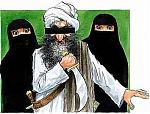The Pentagon this week approved a major policy directive that elevates the military's mission of "irregular warfare" -- the increasingly prevalent campaigns to battle insurgents and terrorists, often with foreign partners and sometimes clandestinely -- to an equal footing with traditional combat.
The directive, signed by Deputy Defense Secretary Gordon England on Monday, requires the Pentagon to step up its capabilities across the board to fight unconventionally, such as by working with foreign security forces, surrogates and indigenous resistance movements to shore up fragile states, extend the reach of U.S. forces into denied areas or battle hostile regimes.
The policy, a result of more than a year of debate in the defense establishment, is part of a broader overhaul of the U.S. military's role as the threat of large-scale combat against other nations' armies has waned and new dangers have arisen from shadowy non-state actors, such as terrorists that target civilian populations.













 "A Sherman can give you a very nice... edge."- Oddball,
"A Sherman can give you a very nice... edge."- Oddball, 
Bookmarks